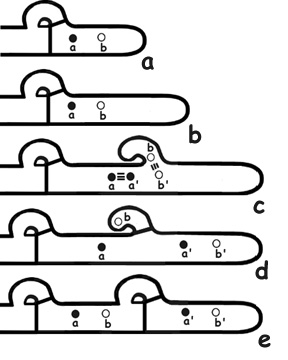
It is believed that the formation
of clamp connections, where they occur in the dikaryons of some species,
function in ensuring that each cell is binucleate. In describing their
formation, below (Fig. 1), note that this is the case.
 |
Figure 1. Formation of Clamp Connections: a. Terminal cell of hypha. Growth only takes place at hyphal tips; b. Hyphal tip elongating. c. Synchronous division of nuclei and the beginning of hyphal branch that will become the clamp connection. One nucleus (b) migrates into the new clamp. d. Septum forms at base of the clamp trapping nucleus b. Nuclei a' and b' migrate to the hyphal tip, while nucleus a migrates away from the tip. e. Septum forms below clamp forming new cell at hyphal tip. Fusion of the clamp to the adjacent cell releases nucleus b to the adjacent cell. Now both the terminal and subterminal are binucleate, each with a compatible pair of nuclei. |